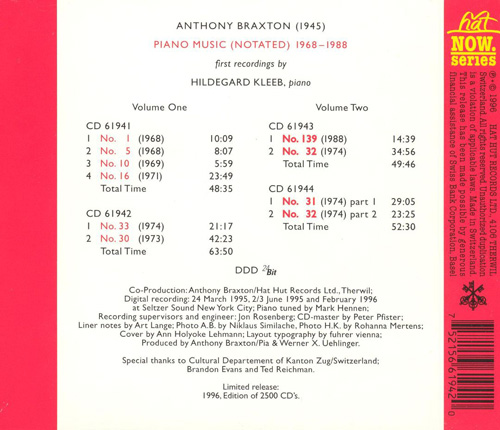In 1995 and 1996, Swiss pianist Hildegard Kleeb recorded a four-CD set
containing nine of Anthony Braxton's notated piano works composed
between 1968 and 1988, beginning with the piece that Braxton chose to
designate as his first numbered "opus": "Composition No. 1 (1968)." Art
Lange's textual commentary describes this thoughtful essay, with its
divergent intervals, as a "song." The sonata-like "Composition No. 5
(1968)" might well have been its sequel. "Composition No. 139 (1988)" is
a conventionally notated song-like cousin to the earlier works. All
three exist within Braxton's designated realm of "frozen improvisation."
These exercises in musical intuition appear to reflect the influence of
Arnold Schoenberg, Anton Webern, and Karlheinz Stockhausen, even while
reflecting Braxton's own developing systems of creativity. "Composition
No. 10 (1969)," dedicated to Russian painter and theoretician Wassily
Kandinsky, uses a graphic score as a blueprint for improvisation. This
means that composer and performer collaborate in ways (and with results)
that cannot occur when every single note and dynamic directive are
written down. "Composition No. 16 for Four Pianos (1971)" was originally
improvised by the composer, and the nature of the graphic/symbolic
score allows for maximum freedom of interpretation. Kleeb's overdubbed
realization is gradual, employs silence as a structural element, and
lasts twice as long as the original. "Composition No. 33 (1974)"
introduces a horde of static nebulae. This work places unusual
responsibilities upon the interpreter, including phraseology, dynamics,
and tempi. Lange compares it with the works of Iannis Xenakis and Morton
Feldman. "Composition No. 30 (1973)" is a living embodiment of Arnold
Schoenberg's cardinal assignment: to search for the sake of searching.
The 82-page score is an expansive and freely formed catalog of ideas and
potential actions. "Composition No. 32 (1974)," resulting from a
76-page score, introduces note clusters which are generated with the
sustaining pedal held to the floor. Lange rightly compares this piece
with works by Cecil Taylor and Olivier Messiaen. The rafts of percussive
tonality are similar to those conjured by Braxton himself when he
demonstrated a thunderous keyboard technique with his Piano Quartet,
recorded live at Yoshi's Nitespot in Oakland, CA in June of 1994.
"Composition No. 31 (1974)" comes from an 85-page score dedicated to
Iannis Xenakis. Here we encounter the most charming surprise of all, as
Braxton is said to have cited Thomas "Fats" Waller as a major early
influence -- right up there with Schoenberg and Stockhausen -- as both
composer and improviser. Art Lange contributes wonderful insights as he
identifies substantial parallels between Waller and Braxton, including
"Collage Logic," "Language Forms, and "Shifting Points of Emphasis."
Precious evidence that all music is relative; that the imagination is a
non-linear, living organism that cannot be confined by critically
cramped pigeon-holing, by historical delineation,or by market-based
categorization; and that the ritual and spiritual functions, as the
composer puts it, are of paramount importance. Composer Anthony Braxton
and his interpreter Hildegard Kleeb have given the world nine piano
rituals that can and will transform anyone who enters with an open mind. arwulf arwulf
Piano Music (I)
1-1 No. 1 (1968) 10:09
1-2 No. 5 (1968) 8:07
1-3 No. 10 (1969) 5:59
1-4 No. 16 (1971) 23:49
2-1 No. 33 (1974) 21:17
2-2 No. 30 (1973) 42:23
Piano Music (II)
3-1 No. 139 (1988) 14:39
3-2 No. 32 (1974) 34:56
4-1 No. 31 (1974) Part 1 29:05
4-2 No. 31 (1974) Part 2 23:25
Credits
Composed By – Anthony Braxton
Piano – Hildegard Kleeb
Producer – Anthony Braxton, Werner X. Uehlinger
15.1.23
ANTHONY BRAXTON — Piano Music (Notated) 1968-1988 (Hildergard Klebb) 4CD (1996) FLAC (tracks+.cue), lossless
Assinar:
Postar comentários (Atom)
+ last month
MORTON FELDMAN : Crippled Symmetry (Dietmar Wiesner · Markus Hinterhäuser · Robyn Schulkowsky) 2CD-SET (1994) FLAC (tracks+.cue), lossless
MORTON FELDMAN (1926-1987) 1-1. Crippled Symmetry 39:00 2-1. Crippled Symmetry (Continued) 55:15 Credits : Flute [Flöte], Bass F...












Link 1
ResponderExcluirhttps://nitroflare.com/view/447916D20B543B5/Anthony_Braxton_-_Piano_Music_(Notated)_1968-1988_1_(Hildegard_Kleeb)_(1996
_hat_ART_-_hat_ART_CD_4-61941-4)_FLAC.rar
Link 2
https://nitroflare.com/view/FFF2F74E8CA0D5A/Anthony_Braxton_-_Piano_Music_(Notated)_1968-1988_2_(Hildegard_Kleeb)_(1996
_hat_ART_-_hat_ART_CD_4-61941-4)_FLAC.rar
Link 3
https://nitroflare.com/view/D2C274A14235DE0/Anthony_Braxton_-_Piano_Music_(Notated)_1968-1988_3_(Hildegard_Kleeb)_(1996
_hat_ART_-_hat_ART_CD_4-61941-4)_FLAC.rar
Link 4
https://nitroflare.com/view/A1B79EA0809C2E8/Anthony_Braxton_-_Piano_Music_(Notated)_1968-1988_4_(Hildegard_Kleeb)_(1996
_hat_ART_-_hat_ART_CD_4-61941-4)_FLAC.rar
Could we get a new link please?
ResponderExcluircaro Monte. novo link no post do Anthony ... enjoy !
Excluirhttps://nitroflare.com/view/21B70A50C899F69/Anthony_Braxton_-_Piano_Music_(Notated)_1968-1988_(Hildegard_Kleeb)_(1996
_hat_ART_-_hat_ART_CD_4-61941-4)_4CD-FLAC.rar
Muito obrigado, Lakhavinor!
ResponderExcluir